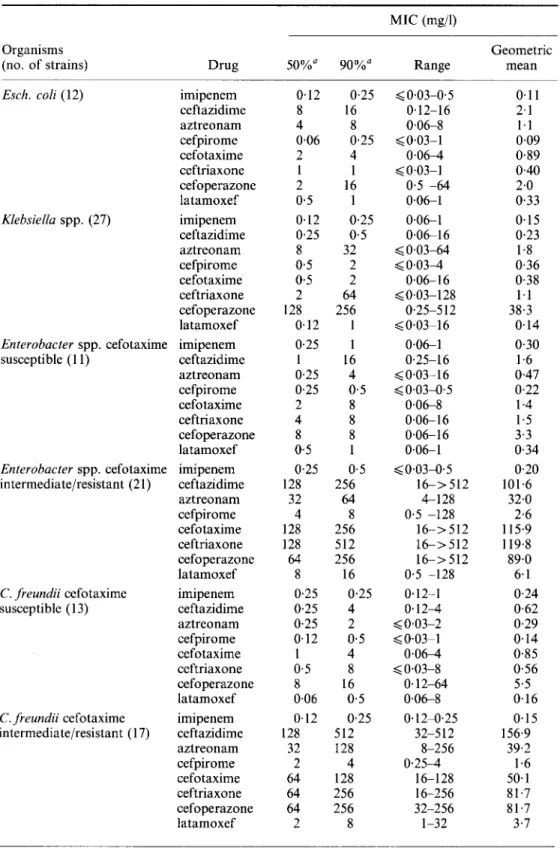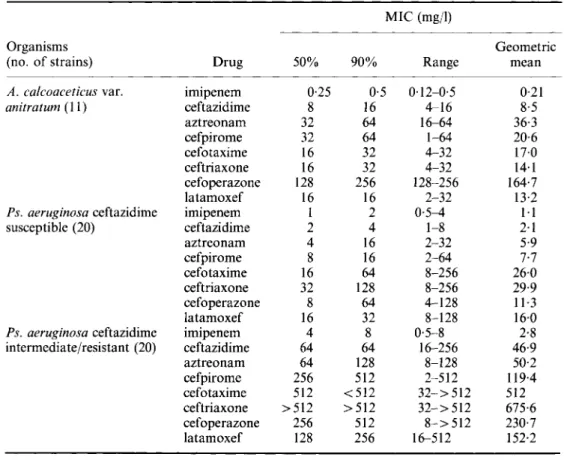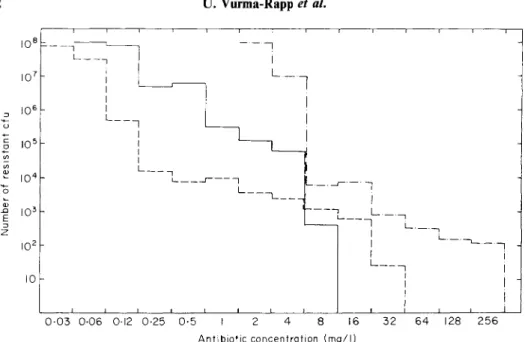Journal of Antimicrobial Chemotherapy (1986) 18, Suppl. E, 27-33
Antibacterial properties of imipenem with special reference to the activity
against methicillin-resistant staphylococci, cefotaxime-resistant
Enterobacteriaceae and
Pseudomonas aeruginosa
U. Vurma-Rapp, F. H. Kayser and
L. Barberis-Maino
Institute of Medical Microbiology, University of Zurich, CH-8028 Zurich P.O. Box,
Switzerland
Imipenem was examined with standardized agar dilution procedures against a wide range of bacteria. Geometric mean MICs against the genera Escherichia, Klebsiella, Enterobacter, Citrobacter and Serratia were 0,1-0,4 mg/I, and Proteus and Providencia spp. were inhibited by 0·25-4 mg/I. Acinetobacter calcoaceticus var. anitratum strains were inhibited by concentrations ranging from 0,12-0,5 mg/I. Methicillin-susceptible staphylococci were highly susceptible to the drug (MICs:
~0'03 mg/I) and enterococci were inhibited by 0'25-16 mg/I. Most of the multi-resistant JK corynebacteria were multi-resistant to imipenem. Imipenem was more active than any other fj-Iactam against methicillin-resistant staphylococci; this was also demonstrated in a population analysis. Imipenem-resistant minorities in populations, however, were also observed. Cefotaxime-resistant and -intermediate Enterobacter and Citrobacter strains were inhibited by concentrations of O' 5 mg/I or less. No third-generation cephalosporin nor any other fj-Iactam showed similarly high activity against these groups of organisms. Among 20 ceftazidime-resistant and 20 ceftazidime-susceptible isolates of Pseudomonas aeruginosa, no strain was resistant and only five ceftazidime-resistant strains were intermediately susceptible (MIC, 8 mg/I) to imipenem.
Introduction
The aim of this work was to study the in-vitro activity of imipenem in comparison with
other broad-spectrum tJ-Iactam antibiotics against a wide range of bacteria.
Materials and methods
Organisms
The bacterial strains used were recently isolated from clinical specimens and identified
according to standard procedures.
Antibiotics
Imipenem (Merck, Sharp
&Dohme), ceftazidime (Glaxo), aztreonam (Squibb),
cefotaxime (Hoechst), cefpirome (HRSlO) (Hoechst-Roussel), ceftriaxone (Hoffman
La Roche), cefoperazone (Pfizer) and latamoxef (Lilly) were kindly supplied by the
manufacturers.
27
Table I. In-vitro activity of imipenem and seven fJ-lactam antibiotics against Enterobacteriaceae MIC (mg/I)
Organisms Geometric
(no. of strains) Drug 50%a 90%a Range mean
Esch. coli (12) imipenem 0·12 0·25 ::'::;0·03-0·5 0·11
ceftazidime 8 16 0·12-16 2·1 aztreonam 4 8 0·06-8 1·1 cefpirome 0·06 0·25 ::'::;0·03-1 0·09 cefotaxime 2 4 0·06-4 0·89 ceftriaxone I 1 ::.::;0·03-1 0·40 cefoperazone 2 16 0·5 -64 2·0 latamoxef 0·5 I 0·06-1 0·33 Klebsiella spp. (27) imipenem 0·\2 0·25 0·06-1 0·15 ceftazidime 0·25 0·5 0·06-16 0·23 aztreonam 8 32 ::.::;0·03-64 1·8 cefpirome 0·5 2 ::.::;0·03-4 0·36 cefotaxime 0·5 2 0·06-16 0·38 ceftriaxone 2 64 ::'::;0·03-128 1·1 cefoperazone 128 256 0·25-512 38·3 latamoxef 0·\2 I ::'::;0·03-16 0·14 Enterobacter spp. cefotaxime imipenem 0·25 I 0·06-1 0·30
susceptible (II) ceftazidime I 16 0·25-16 1·6
aztreonam 0·25 4 ::'::;0·03-16 0·47 cefpirome 0·25 0·5 ::.::;0·03--0·5 0·22 cefotaxime 2 8 0·06-8 l-4 ceftriaxone 4 8 0·06-16 1·5 cefoperazone 8 8 0·06-16 3·3 latamoxef 0·5 I 0·06-1 0·34
Enterobacter spp. cefotaxime imipenem 0·25 0·5 ::.::;0·03--0·5 0·20 intermediate/resistant (21) ceftazidime 128 256 16->512 101·6 aztreonam 32 64 4-128 32·0 cefpirome 4 8 0·5 -128 2·6 cefotaxime 128 256 16->512 115·9 ceftriaxone 128 512 16->512 119·8 cefoperazone 64 256 16->512 89·0 latamoxef 8 16 0·5 -128 6·1
C. freundii cefotaxime imipenem 0·25 0·25 0·\2-1 0·24
susceptible (13) ceftazidime 0·25 4 0·12-4 0·62 aztreonam 0·25 2 ::'::;0·03-2 0·29 cefpirome 0·\2 0·5 ::'::;0·03-1 0·14 cefotaxime I 4 0·06-4 0·85 ceftriaxone 0·5 8 ::'::;0·03-8 0·56 cefoperazone 8 16 0·12-64 5·5 latamoxef 0·06 0·5 0·06-8 0·16
C. freundii cefotaxime imipenem 0·\2 0·25 0·12-0·25 0·15 intermediate/resistant (17) ceftazidime 128 512 32-512 156·9 aztreonam 32 128 8-256 39·2 cefpirome 2 4 0·25-4 1·6 cefotaxime 64 128 16-128 50·1 ceftriaxone 64 256 16-256 81·7 cefoperazone 64 256 32-256 81·7 latamoxef 2 8 1-32 3·7
In-vitro antibacterial activity of imipenem 29 Table I-contd.
MIC (mg/I)
Organisms Geometric
(no. of strains) Drug 50%a 90%a Range mean
--~--~----~~~-~~-~~---.--~-Ser. marcescens (25) imipenem 0·5 0·5 0'12-1 0·41
ceftazidime 0·5 2 0·06-16 0·44 aztreonam 0·5 8 0'06-8 0·74 cefpirome 0·5 1 ~0'03--4 0·34 cefotaxime 8 32 0'12-32 3·1 ceftriaxone 2 16 0'06-32 1·7 cefoperazone 64 128 8-128 43-4 latamoxef 0·25 8 0'12-16 0·76
Proteus and Providencia imipenem 1 2 0·25--4 0·75
Spp.b (19) ceftazidime 0·06 0·5 ~0·03-1 0·05 aztreonam ~0·03 0·03 ~0'03-0'06 ~0'03 cefpirome 0·5 4 0·12--4 0·77 cefotaxime ~0'03 0·06 ~0·03-0·25 ~0'03 ceftriaxone ~0'03 0·03 ~0·03-O·06 ~0·03 cefoperazone ~0'03 0·03 ~0·03-O·06 ~0·03 latamoxef 0·25 0·5 ~0·03-O·5 0·17
aMIC50 and MIC90 are the concentrations of antibiotics required to inhibit 50% and 90% of the
examined strains, respectively.
b Prot. mirabilis (6), Prot. vulgaris (6), Provo rettgeri (4), Provo stuartii (3).
Methods
Minimal inhibitory concentrations (MICs) were determined according to the NCCLS
agar-dilution procedure (National Committee for Clinical Laboratory Standards
(NCCLS) (1985». Mueller-Hinton medium with 3% agar content was used to prevent
swarming of
Providenciaand
Proteusspp. Gonococci (GC) agar base supplemented
with 5% defibrinated sheep blood was used for JK corynebacteria.
A population of methicillin-resistant staphylococci was analysed by disaggregation
of overnight broth cultures (brief ultrasonication at 20 kHz) and surface inoculation
on to drug-containing Mueller-Hinton agar plates with 0·1 ml of appropriate dilutions
of the processed broth. Incubation was at 37°C for 48 h. Colony counts served to
calculate the number of resistant cells in a population of 10
8cfu.
Results
The MICs for the Gram-negative and Gram-positive organisms used to define the
spectrum of imipenem are presented in Tables I to III. Imipenem was highly active
against the Enterobacteriaceae; exceeding the activity of most of the other p-lactam
antibiotics tested (Table I). The drug showed less activity against
Proteusand
Providenciaspp., but MICs were still below the susceptibility threshold of :0:;4 mg/I.
Imipenem was equally active against
Enterobacterand
Citrobacterstrains resistant or
susceptible to cefotaxime. Most of the cefotaxime-resistant strains were also resistant
to ceftazidime, aztreonam, ceftriaxone and cefoperazone. Cefpirome and latamoxef
Table II. In-vitro activity of imipenem and seven p-Iactam antibiotics against A. anitratus and Ps. aeruginosa
MIC (mg/I)
Organisms Geometric
(no. of strains) Drug 50% 90% Range mean
A. calcoaceticus var. imipenem 0·25 0·5 0,12-0,5 0·21
anitratum (II) ceftazidime 8 16 4-16 8·5
aztreonam 32 64 16-64 36·3 cefpirome 32 64 1-64 20·6 cefotaxime 16 32 4-32 17·0 ceftriaxone 16 32 4-32 14·1 cefoperazone 128 256 128-256 164·7 latamoxef 16 16 2-32 I3-2
Ps. aeruginosa ceftazidime imipenem I 2 0·5-4 1·1
susceptible (20) ceftazidime 2 4 1-8 2·1 aztreonam 4 16 2-32 5·9 cefpirome 8 16 2-64 7-7 cefotaxime 16 64 8-256 26·0 ceftriaxone 32 128 8-256 29·9 cefoperazone 8 64 4-128 11·3 latamoxef 16 32 8-128 16·0
Ps. aeruginosa ceftazidime imipenem 4 8 0'5-8 2·8
intermediate/resistant (20) ceftazidime 64 64 16-256 46·9 aztreonam 64 128 8-128 50·2 cefpirome 256 512 2-512 119·4 cefotaxime 512 <512 32->512 512 ceftriaxone >512 >512 32->512 675·6 cefoperazone 256 512 8->512 230·7 latamoxef 128 256 16-512 152·2
exerted good activity against these problem strains, although the geometric means of their MICs were 10-20 times higher than against cefotaxime-susceptible Enterobacter and Citrobacter spp.
Imipenem was the most active amongst the agents tested against Acinetobacter
calcoaceticus var. anitratum and Pseudomonas aeruginosa, whether susceptible or resistant to ceftazidime (Table II). MICs of imipenem against ceftazidime-resistant
Ps. aeruginosa were only slightly higher than against susceptible strains. This finding was in sharp contrast to the results obtained with the other p-Iactams. The latter all showed highly elevated MICs against the ceftazidime-resistant strains. Cross-resistance was not observed between imipenem and the other drugs examined. Imipenem was highly active against methicillin-susceptible staphylococci (Table III). Compared with the activity against other Gram-positive bacteria (Tischhauser
&
Kayser, 1983), the drug's activity against enterococci was relatively low. However, 50% of the enterococci were inhibited by 1 mg/l and 90% by 8 mg/l of the drug, respectively. These values were much lower than those of the other p-lactams examined. Antistaphylococcal activity of imipenem was generally superior to that of the other p-lactams tested. Methicillin-resistant staphylococci were inhibited by higher imipenem concentrations than susceptible isolates but only 5% of the strains had MICs above the susceptibilityIn-vitro antibacterial activity of imipenem 31
Table
m.
In-vitro activity of imipenem and six fJ-lactam antibiotics against Gram-positive organismsMIC(mgjl)
Organisms Geometric
(no. of strains) Drug 50% 90% Range mean
Staph. aureus methicillin imipenem ~0·03 ~0·03 ~0·03 ~0·03
susceptible (19) ceftazidime 8 16 4-16 8·9 cefpirome 1 1 0·12-1 0·58 cefotaxime 2 4 0·5 -4 1·7 ceftriaxone 4 8 1-8 3·0 cefoperazone 2 4 1-4 1·9 latamoxef 16 16 8-16 9·3
Staph. aureus methicillin imipenem ~0·03 0·12 ~0·03-64 0·07
resistant (19) ceftazidime 32 128 4-512 32·0 cefpirome 2 32 0·5 -64 2·5 cefotaxime 16 128 1->512 12·4 ceftriaxone 16 256 2->512 17·9 cefoperazone 16 32 1->512 15·4 latamoxef 32 128 8->512 33·2 Coagulase-negative imipenem ~0·03 ~0·03 ~0·03 ~0·03
staphylococcus methicillin ceftazidime 8 16 4-16 6·7
susceptible (16) cefpirome 0·25 0·5 0·12-2 0·25
cefotaxime 1 4 0·5 -8 1·6
ceftriaxone 2 4 0·5 -8 1·5
cefoperazone 2 4 0·5 -4 1·5
latamoxef 16 32 8-32 18·2
Coagulase-nega tive imipenem 0·06 0·5 ~0·03-16 0·09
staphylococcus methicillin ceftazidime 8 32 0·5 -32 8·9
resistant (20) cefpirome 0·5 4 0·06-16 0·71 cefotaxime 2 8 0·06-16 2·3 ceftriaxone 4 32 0·12-32 4·4 cefoperazone 2 4 0·25-8 2·1 latamoxef 32 64 8-128 34·3 Enterococci (20) imipenem 1 8 0·25-16 1·9 ceftazidime >512 >512 128->512 749·6 cefpirome 16 512 1->512 34·3 cefotaxime 256 512 32->512 294·1 ceftriaxone 128 512 4->512 123·6 cefoperazone 64 512 8-512 64·0 latamoxef >512 >512 128->512 861·1 Multiresistant JK imipenem 256 512 0·5 ->512 115·9 corynebacteria (14) ceftazidime >512 >512 128->512 655·8 cefpirome 512 >512 4->512 141·3 cefotaxime >512 >512 8->512 269·0 ceftriaxone >512 >512 8->512 243-6 cefoperazone >512 >512 16->512 231·9 latamoxef >512 >512 256->512 760·8
breakpoint of 4 mg/I. Figure I shows the population analysis of the pencillinase-negative Staphylococcus aureus strain FK 362 with respect to imipenem, penicillin G and methicillin. Although heterogeneity was also found with imipenem, the population was more susceptible to imipenem than to penicillin G and to methicillin.
32
108 107 ::> 106 u ..:: 105 .2 <n <n ~ 104 '0 ~ 103 .0 E ::> Z 102 10--,
L __ , I I I I Il
L __ , I I I I L __ , U. Vurma-Rapp et al.--,
I L_l
I
II
I '---'--, L_.--.r-·_·, L __ ' - __ -, ---, L'---,
---, - - - L _ - - , I '-I -~-, I i L __ , I : I I I I j 0,03 0·06 0,12 0,25 0,5 2 4 8 16 32 64 128 256 Antibiotic concentration (mg/l)Figure 1. Number of viable units resistant to each concentration of antimicrobial agent remaining after plating an inoculum of 108 cfu of methicillin-resistant, fJ-lactamase-negative Staph, aureus strain FK 362 and
incubating at 37°C for 48 h (- - - imipenem; - - penicillin G; - ' - ' - methicillin),
Discussion
An outstanding property of imipenem is its activity against strains of
Enterobacteriaceae resistant to third-generation cephalosporins, This property may be
due to the stability of imipenem to the chromosomal cephalosporinase responsible for
resistance in these organisms (Livermore, Williams & Williams, 1981; See berg,
Tolxdorff-Neutzling
&Wiedemann, 1983) as well as its high penetrability through the
outer membrane of Gram-negative bacteria due to its zwitterionic character and
compact molecular structure (Yoshimura
&Nikaido, 1985), Stability to p-lactamases
and good penetrability of the cell wall also could explain the activity of imipenem
against ceftazidime-resistant
Ps. aeruginosa.Another outstanding feature of imipenem is its activity against Gram-positive cocci
including the enterococci. The majority of the methicillin-resistant staphylococci were
susceptible to imipenem in standard agar dilution tests, but with an inoculum of 10
4cells per spot and incubation for 20 h at 35°C, these tests were unfavourable for the
expression of intrinsic resistance to p-lactam antibiotics in staphylococci. The majority
of cells in a population of methicillin-resistant
Staph. aureuswill be susceptible to
imipenem, but minorities of a few more or less resistant cells may occur. Despite this
situation, imipenem seems to be an effective agent in the treatment of infections caused
by methicillin-resistant staphylococci (Fan
et al., 1986).Thus, imipenem presents an impressive potential in the therapy of bacterial
infections.
References
Fan, W" Del Busto, R., Love, M., et al. (1986). Imipenem-cilastatin in the treatment of methicillin-sensitive and methicillin-resistant Staphylococrus aureus infections, Antimicrobial Agents and Chemotherapy 29,26-9.
In-vitro antibacterial activity of imipenem 33 Livermore, D. M., Williams, R. J. & Williams, J.D. (1981). In-vitro activity of MK 0787
(N-formimidoy1thienamycin) against Pseudomonas aeruginosa and other Gram-negative organisms and its stability to their fJ-lactamases. Journal of Antimicrobial Chemotherapy 8, 355-62.
National Committee for Clinical Laboratory Standards (1985). Methods for dilution antimicrobial susceptibility tests for bacteria that grow aerobically; Approved Standard NCCLS publication M7-A. NCCLS, Villanova, Pa.
Seeberg, A. H., Tolxdorff-Neutzling, R. M. & Wiedemann, B. (1983). Chromosomal beta-lactamases of Enterobacter cloacae are responsible for resistance to third-generation cephalosporins. Antimicrobial Agents and Chemotherapy 23,918-25.
Tischhauser, G. & Kayser, F. H. (1983). The in vitro activity of N-formimidoyl thienamycin compared with other broad-spectrum cephalosporins and with clindamycin and metronidazole. Infection 11, 219-26.
Yoshimura, F. & Nikaido, H. (1985). Diffusion of beta-lactam antibiotics through the porin channels of Escherichia coli K12. Antimicrobial Agents and Chemotherapy 27, 84-92.


